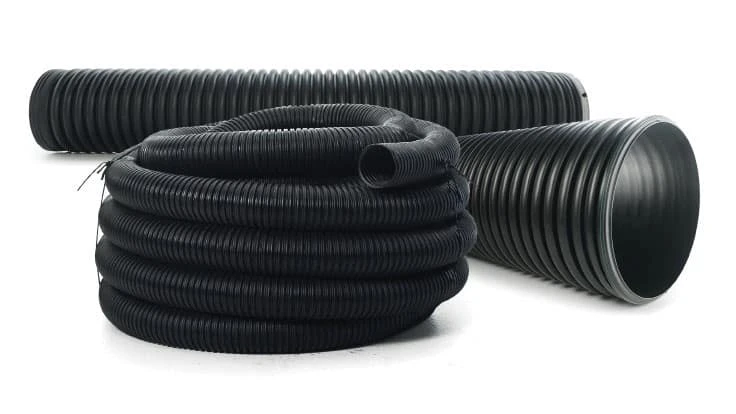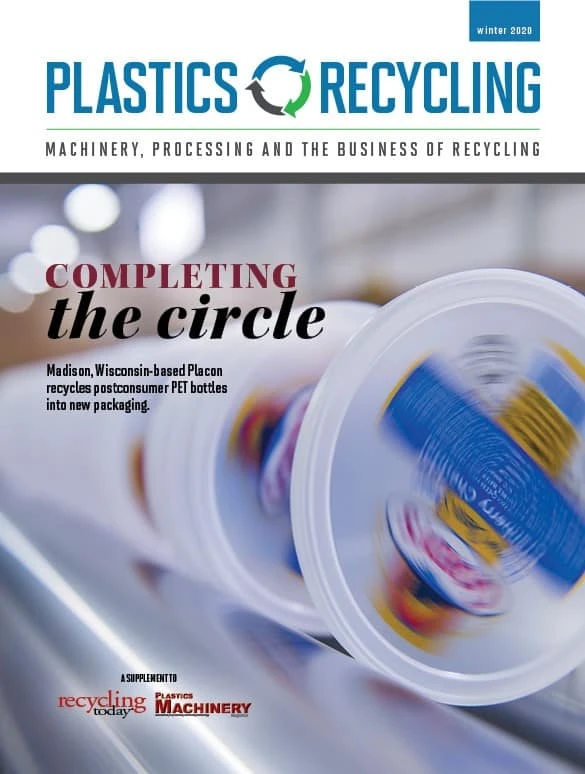
Plastics Pipe Institute

Recyclers and processors of postconsumer and postindustrial high-density polyethylene (HDPE) have the chance to seize an undeveloped market: corrugated pipe used in public storm drains and railroad and highway culverts.
For decades, manufacturers of corrugated HDPE pipes for agricultural and private-sector storm drains have incorporated recycled resin into their products. But, until 2018, when two important standards changed, pipes for public storm drains and culverts were made strictly using virgin resin.
With the changes to the standards—the American Association of State Highway and Transportation Officials (AASHTO) M 294-18 and the American Society for Testing and Materials (ASTM) International F 2306—pipe manufacturers can put their plans for recycled-content pipes into high gear.
“Anytime you get public right-of-way application, it kind of raises the ceiling for everything just because it gives engineers in general a greater confidence of, this is good enough for the [public],” says Daniel Currence, director of engineering for the drainage division of the Plastics Pipe Institute (PPI), Irving, Texas.
Currence was part of the review panel for the National Cooperative Highway Research Program (NCHRP) research that evaluated the use of recycled material in HDPE pipe. AASHTO member states fund NCHRP. AASHTO looked to PPI to provide input and feedback on behalf of the entire corrugated HDPE pipe industry as it considered revisions to its standards.
The opportunity for recycled HDPE is huge. In all markets, including agriculture, private and public storm drains and highway/ railroad culverts, about 1 billion pounds of HDPE go into the ground as pipes annually in the U.S., Currence says. PPI does not have statistics by market sector, but Currence says that, overall, hundreds of millions of pounds of recycled HDPE are currently being used annually. And, thanks to the new standards, he says he sees those numbers increasing substantially.
Testing for durability
The standards are based on pipe performance and don’t specify an allowable maximum percentage of recycled resin.
“The acceptability of the resin blend is based on its ability to pass tests designed to predict 100-year service life,” Currence says. “This allows a manufacturer to make decisions that may be unique for their preferred processing or unique based on their source or quality of recycled material being incorporated.”
Typical recycled-content quantities could range from 40 percent to 60 percent.
Before the standards could be changed, researchers had to prove that pipes with recycled HDPE would last just as long as those produced from virgin resin. To validate the pipes’ durability, Crossroads Engineering Services, a consulting firm based in Breezy Point, Minnesota, that performed the research, came up with several new laboratory tests.
One of the new assessments, the Unnotched Constant Ligament Stress (UCLS), involves cracking a pipe, then studying how the crack advances over time to predict how long the pipe can function until failure.
“And as long as its failure time on the UCLS test was above a certain number of hours, then that correlated to something that would last more than 100 years,” says Michael Pluimer, president of Crossroads Engineering Services.
Another assessment involved pulling apart a specimen until it fractured.
Pluimer says the tests demonstrate that people can have confidence in pipe with recycled content.
Acceptance of recycled-content pipes
Advanced Drainage Systems (ADS), Hilliard, Ohio, which is the largest U.S. maker of thermoplastic corrugated pipe, currently is producing HDPE pipe that meets the new AASHTO and ASTM standards. Last year, the company used about 400 million pounds of recycled plastic in all its pipe products.
Joe Babcanec, ADS national engineering program manager, applauds the spec change. He says being able to use recycled HDPE in public infrastructure provides a steady outlet for the material.
ADS has its own recycling facilities and its own recycling subsidiary, Green Line Polymers, that processes bales of postconsumer and postindustrial HDPE into clean flake. Green Line Polymers has eight facilities across the U.S. “Much, if not most, of the recycled material we use in our HDPE pipe is actually processed in our own recycling facilities,” Babcanec says.

According to the publicly traded company’s most recent annual report, Green Line Polymers met 91 percent of ADS’ demand for recycled HDPE last year. ADS also purchased 250 million pounds of postconsumer plastic and 150 million pounds of postindustrial plastic in 2019, the report says, making it the sixth-largest recycling company in North America. In the same year, the company consumed 30 percent of the pigmented HDPE bottles recycled in the U.S. Over the past decade, the percentage of recycled HDPE used in its pipe has increased to 56 percent from 24 percent.
Babcanec says he’s seen “solid acceptance” of recycled-content HDPE pipe with many of the state departments of transportation nationwide.
But “we have not seen the big windfall yet,” Currence says. In part that is because states have to change their rules to begin accepting recycled-content pipes. And some of it might be because of the natural cautiousness of engineers—the people at the frontline of determining sourcing for infrastructure needs. Transportation departments for all 50 states approved the use of pipes made with recycled HDPE.
“There’s no question that this is going to change the market considerably,” Pluimer says.
His confidence is fueled by growing public demand for more environmentally responsible material choices. The tests show pipes with recycled content can perform just as well as those made only from virgin material. As an additional benefit, there is the cost benefit of having more supply options when resin prices fluctuate. As Currence points out, though the cost difference between recycled and virgin resins varies, recycled resins generally are 10 percent less than virgin resins.
While much of the world is ahead of the U.S. in terms of recycling, the country is at the forefront of using recycled content in plastic pipe, Currence says. So, there’s potential for an opening of global markets for recycled-content plastic pipes.
“It’s rare that we can get something that’s a win-win-win for everybody,” Pluimer says. “It’s a win for taxpayers because they can get a more cost-effective product. … It’s a win for state departments of transportation who can use more sustainable materials for their applications and potentially save some money in the process. And, certainly, it’s a win for the manufacturers, who can now choose from different material streams and incorporate them into their pipes. And then largely for the consumers and our environment because plastics have a lot of negative press, and kind of rightly so, and here we’re taking a lot of these waste plastics that we don’t want to end up in our landfills and putting them into something that’s going to last 100 years underneath our streets.”
Get curated news on YOUR industry.
Enter your email to receive our newsletters.

Explore the Winter 2020 Plastics Recycling Issue
Check out more from this issue and find your next story to read.
Latest from Recycling Today
- Green Cubes unveils forklift battery line
- Rebar association points to trade turmoil
- LumiCup offers single-use plastic alternative
- European project yields recycled-content ABS
- ICM to host colocated events in Shanghai
- Astera runs into NIMBY concerns in Colorado
- ReMA opposes European efforts seeking export restrictions for recyclables
- Fresh Perspective: Raj Bagaria






